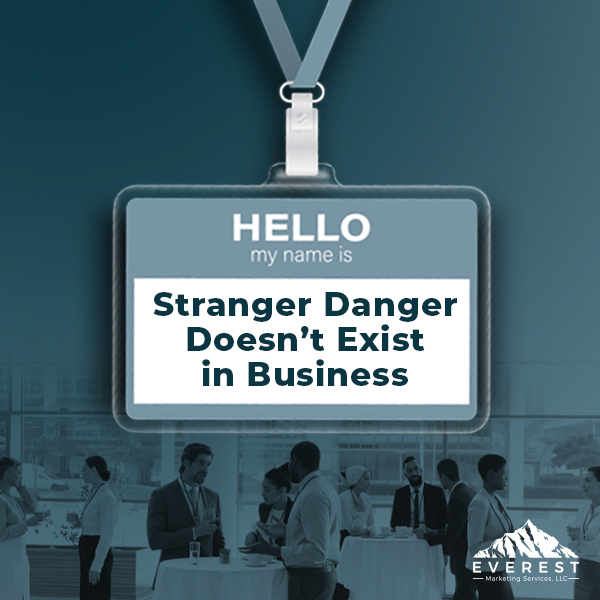It’s time for the Everest Marketing version of David Letterman’s Top 10 List. (We’ll shorten it to save reading time. I get it. You’re busy.)

Catch the drift? Talking to strangers is intimidating and can make us self-conscious, self-doubting, and tongue-tied. If we were in grade school, we could run away from strangers. But in business, we must overcome extraordinary fear and apply simple tips to kick off introductory conversations.
Here are 14 practical and proven tips to help you break the ice with strangers:
- Smile: A warm smile is the universal icebreaker. It conveys approachability and friendliness, making it easier for others to engage with you. Practice your warm smile in the mirror so you get comfortable and confident.
- Maintain open body language: Stand or sit with a relaxed, open posture to signal that you are receptive to communication and help put others at ease. Do NOT cross your arms, wring your hands, grip your portfolio tightly, or slump.
- Listen actively: Pay close attention to the person when they speak. Show genuine interest in their words, nod in agreement, and make eye contact to demonstrate respect and foster rapport. Smile some more.
- Prepare conversation starters: Have a few go-to conversation starters in your back pocket, such as asking about their day, discussing a shared experience or interest, or complimenting something about them. Here are a few more: Tell me about where you grew up. How long have you lived in this area? What brings you here (to this event)? What’s your one piece of advice to everyone here? What question do you wish people would ask you? What is one thing we would never guess about you? What’s one thing you want to do but need help knowing where to start? Keep an icebreaker list on your phone or computer and plan your questions about the meeting or event.
- Look around: Use your environment as a conversation starter. Comment on something in your immediate surroundings, like a piece of art, the weather, or a shared experience like waiting in line.
- Introduce yourself: A simple introduction can break the ice. Say your name and offer a handshake if appropriate. It’s a polite and non-intrusive way to initiate a conversation.
- Be empathetic: Always try to understand the other person’s perspective to make your interactions more meaningful and compassionate. Remember that “relate” is part of a relationship.
- Ask open-ended questions: Instead of yes-or-no questions, ask open-ended ones that encourage more extended responses to allow the conversation to flow naturally and help you get to know the person better. Use probing statements to enable them to speak: Tell me more, how so, uh-huh.
Be genuine and considerate. Be yourself, respectful, and open to the possibilities that come from connecting with new people. Over time, your confidence in this skill will naturally grow.
Most professionals have adequate technical skills to perform their jobs. Communication skills are the hardest to master. I provide training that blends a veteran’s insights, communication best practices, and practical application to set the stage for professional satisfaction and career growth.





